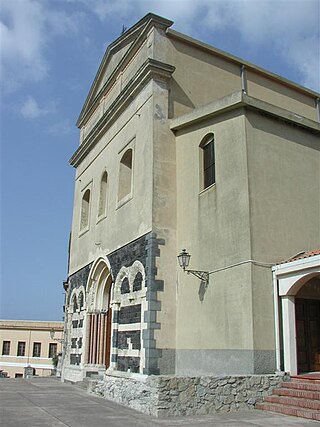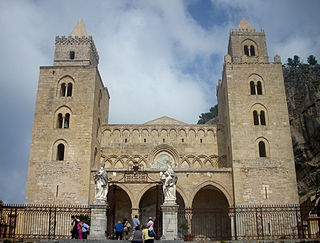
The Archdiocese of Capua is a Latin diocese of the Catholic Church in Capua, in Campania, Italy, but its archbishop no longer holds metropolitan rank and has no ecclesiastical province. Since 1979, it is a suffragan of the Archdiocese of Napoli, i.e. no longer has its own ecclesiastical province nor metropolitan status.

The Diocese of Patti is a Latin diocese of the Catholic Church located on the north shore of the island of Sicily. It is a suffragan of the Archdiocese of Messina-Lipari-Santa Lucia del Mela. Its patron saint is Bartholomew the Apostle, in whose honor the cathedral is named.

The Archdiocese of Manfredonia–Vieste–San Giovanni Rotondo is a Latin Church non-Metropolitan Archdiocese of the Catholic Church in the civil province of Foggia, in Apulia, south-eastern Italy, which is part the ecclesiastical province of the Metropolitan Archdiocese of Foggia-Bovino

The Metropolitan Archdiocese of Palermo is a Latin diocese of the Catholic Church. It was founded as the Diocese of Palermo in the first century and raised to the status of archdiocese in the 11th century. The archbishop is Corrado Lorefice.

The Roman Catholic Diocese of Ferentino existed until 1986, when it was united into the new diocese of Frosinone-Veroli-Ferentino.

The Diocese of Rieti is a Latin Church ecclesiastical territory or diocese of the Catholic Church in Italy. It is immediately exempt to the Holy See. Its cathedra is in St. Mary Cathedral in the episcopal see of Rieti.

The Archdiocese of Reggio Calabria-Bova is a Latin Church ecclesiastical territory or diocese of the Catholic Church in Calabria, southern Italy. It received its current title in 1986, when the independent Diocese of Bova was suppressed, and the territory and title of the diocese added to that of the Archdiocese of Reggio.

The Diocese of Cassano all'Jonio is a Latin diocese of the Catholic Church in Calabria.

The Diocese of Mazara del Vallo is a Latin diocese of the Catholic Church in far western Sicily. It is a suffragan of the Archdiocese of Palermo.

The Diocese of Squillace was a Latin Church ecclesiastical jurisdiction or diocese of the Catholic Church in Calabria, Italy. The diocese was established in the 5th century, and suppressed in 1986. In that year, it was combined into the Archdiocese of Catanzaro-Squillace. It was a suffragan of the archdiocese of Reggio in Calabria.

The Archdiocese of Agrigento is a Latin Church ecclesiastical jurisdiction or archdiocese of the Catholic Church in Sicily, Italy. The historic diocese of Agrigento was also known as the Diocese of Girgenti, and Diocese of Agrigentum. It used to be a suffragan of the Archdiocese of Monreale. A metropolitan see, the Archdiocese of Agrigento has two suffragan dioceses in its ecclesiastical province.

The Archdiocese of Siracusa, also known as Syracuse, is a Latin Church ecclesiastical territory or diocese of the Catholic Church in Sicily. It became an archdiocese in 1844. The current archbishop is Francesco Lomanto.

The Archdiocese of Catania is a Latin Church diocese of the Catholic Church in Sicily, southern Italy, with its seat in Catania. It was elevated to an archdiocese in 1859, and became a metropolitan see in 2000. Its suffragans are the diocese of Acireale and the diocese of Caltagirone.

The Diocese of Ischia is a Latin diocese of the Catholic Church in Campania, southern Italy. It is a suffragan of the Archdiocese of Naples. The diocese comprises the entire island of Ischia, which contains seven communes divided into two circumscriptions. In 1743, the population was about 4,000. The city of Ischia constituted one single parish, with two religious houses of men and one of women. In 2018, the population of the town of Ischia was 20,118.

The Diocese of Pozzuoli is a Latin diocese of the Catholic Church in Campania, southern Italy. It is a suffragan of the Metropolitan Roman Catholic Archdiocese of Naples, like its other neighboring dioceses, Aversa and Ischia.

The Diocese of Caserta is a Latin diocese of the Catholic Church in Campania, southern Italy. It is a suffragan of the Archdiocese of Naples. In 1818 Pope Pius VII united this see with the diocese of Caiazzo, but Pope Pius IX made them separate sees. In 2013 in the diocese of Caserta there was one priest for every 1,703 Catholics; in 2016, there was one priest for every 2,008 Catholics. The diocesan Major Seminary currently (2019) has four seminarians.

The Archdiocese of Monreale is a Latin archdiocese of the Catholic Church in Sicily. As of 2000 it is no longer a metropolitan see, and is now a suffragan of the Archdiocese of Palermo.

The Diocese of Cefalù is a Latin diocese of the Catholic Church in Sicily, southern Italy. It is a suffragan of the Archdiocese of Palermo.
The Italian Catholic diocese of Lacedonia, a suffragan of the archdiocese of Benevento in Campania, existed until 1986 when incorporated into the reorganized Roman Catholic Diocese of Ariano Irpino-Lacedonia.

The Roman Catholic Diocese of Lipari was a Latin diocese of the Roman Catholic Church located in the town of Lipari in the Aeolian Islands of Sicily, Italy. The diocese consists of the entire island of Lipari as well as seven smaller adjacent islands. It is now incorporated into the Archdiocese of Messina-Lipari-Santa Lucia del Mela.























